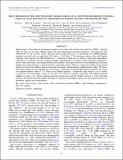Files in this item
First high-resolution spectroscopic observations of an erupting prominence within a coronal mass ejection by the Interface Region Imaging Spectrograph (IRIS)
Item metadata
| dc.contributor.author | Liu, Wei | |
| dc.contributor.author | De Pontieu, Bart | |
| dc.contributor.author | Vial, Jean-Claude | |
| dc.contributor.author | Title, Alan M. | |
| dc.contributor.author | Carlsson, Mats | |
| dc.contributor.author | Uitenbroek, Han | |
| dc.contributor.author | Okamoto, Takenori J. | |
| dc.contributor.author | Berger, Thomas E. | |
| dc.contributor.author | Antolin, Patrick | |
| dc.date.accessioned | 2017-02-14T10:30:21Z | |
| dc.date.available | 2017-02-14T10:30:21Z | |
| dc.date.issued | 2015-04-21 | |
| dc.identifier | 248969701 | |
| dc.identifier | df30b2e8-adfb-4052-821a-881aaf6e0035 | |
| dc.identifier | 84928495687 | |
| dc.identifier.citation | Liu , W , De Pontieu , B , Vial , J-C , Title , A M , Carlsson , M , Uitenbroek , H , Okamoto , T J , Berger , T E & Antolin , P 2015 , ' First high-resolution spectroscopic observations of an erupting prominence within a coronal mass ejection by the Interface Region Imaging Spectrograph (IRIS) ' , Astrophysical Journal , vol. 803 , 85 . https://doi.org/10.1088/0004-637X/803/2/85 | en |
| dc.identifier.issn | 0004-637X | |
| dc.identifier.other | BibCode: 2015ApJ...803...85L | |
| dc.identifier.uri | https://hdl.handle.net/10023/10287 | |
| dc.description.abstract | Spectroscopic observations of prominence eruptions associated with coronal mass ejections (CMEs), although relatively rare, can provide valuable plasma and three-dimensional geometry diagnostics. We report the first observations by the Interface Region Imaging Spectrograph mission of a spectacular fast CME/prominence eruption associated with an equivalent X1.6 flare on 2014 May 9. The maximum plane-of-sky and Doppler velocities of the eruption are 1200 and 460 km s−1, respectively. There are two eruption components separated by ~200 km s−1 in Doppler velocity: a primary, bright component and a secondary, faint component, suggesting a hollow, rather than solid, cone-shaped distribution of material. The eruption involves a left-handed helical structure undergoing counterclockwise (viewed top-down) unwinding motion. There is a temporal evolution from upward eruption to downward fallback with less-than-free-fall speeds and decreasing nonthermal line widths. We find a wide range of Mg ii k/h line intensity ratios (less than ~2 expected for optically-thin thermal emission): the lowest ever reported median value of 1.17 found in the fallback material, a comparably high value of 1.63 in nearby coronal rain, and intermediate values of 1.53 and 1.41 in the two eruption components. The fallback material exhibits a strong (>5α ) linear correlation between the k/h ratio and the Doppler velocity as well as the line intensity. We demonstrate that Doppler dimming of scattered chromospheric emission by the erupted material can potentially explain such characteristics. | |
| dc.format.extent | 12 | |
| dc.format.extent | 2960571 | |
| dc.language.iso | eng | |
| dc.relation.ispartof | Astrophysical Journal | en |
| dc.subject | Sun: activity | en |
| dc.subject | Sun: corona | en |
| dc.subject | Sun: coronal mass ejections: CMEs | en |
| dc.subject | Sun: filaments | en |
| dc.subject | Prominences | en |
| dc.subject | Sun: UV radiation | en |
| dc.subject | QB Astronomy | en |
| dc.subject | QC Physics | en |
| dc.subject | NDAS | en |
| dc.subject.lcc | QB | en |
| dc.subject.lcc | QC | en |
| dc.title | First high-resolution spectroscopic observations of an erupting prominence within a coronal mass ejection by the Interface Region Imaging Spectrograph (IRIS) | en |
| dc.type | Journal article | en |
| dc.contributor.institution | University of St Andrews. Applied Mathematics | en |
| dc.identifier.doi | 10.1088/0004-637X/803/2/85 | |
| dc.description.status | Peer reviewed | en |
| dc.identifier.url | http://adsabs.harvard.edu/abs/2015ApJ...803...85L | en |
This item appears in the following Collection(s)
Items in the St Andrews Research Repository are protected by copyright, with all rights reserved, unless otherwise indicated.

